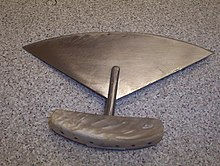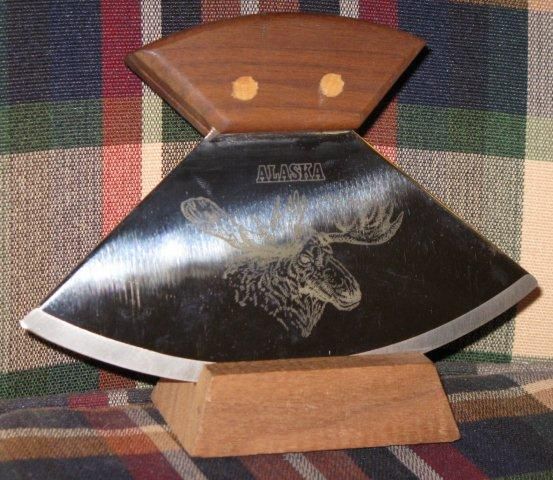The Ulu
Posted: Tue Oct 23, 2012 7:47 am
The Ulu knife or "Woman's knife" was typically made and used by the Eskimos natives. Early Ulu knives were made of flat rocks, slate or even Jade and had bone or wood handles. Ulu knives were used by the Eskimo people to process the seals, Walrus and Fish that they used in their everyday lives. These knives were used for skinning, scraping and cutting. The Ulu knife has a very distinctive shape and only one edge is sharpened. The knives were also used to trim blocks of snow and ice used to build igloos.
Today a lot of people use Ulu knives, especially for preparing food.
The rocking motion allowed by its shape is especially helpful for dicing vegetables.
See how to use an Ulu Knife here
Here is the Wikipedia take on the Ulu knife:
A West Arctic Ulu

A West Greenlandic Ulu

An East Greenlandic Ulu

An Alaskan Ulu
Images and text are from Here
This particular example, I believe, is one made for the Tourist trade and has never been used. The steel appears to be stainless steel but the edge has not really been fully sharpened. It will cut but it's not razor sharp. The yellow cast in the photo is due to the mirror finish of the blade reflecting the light; as the images were taken by incandescent light. The first image is more indicative of the actual colors. This example has a birch handle. My wife picked it up at a garage sale for $2.

The Alaskan Ulu on it's display stand

A Bear catching Salmon is etched on the front side

The rear with its unsharpened edge.

You can see the edge of the blade here. The bevel going towards the actual cutting edge.
Some commercial Ulu makers:
http://www.ulu.com
http://theulufactory.com
http://fishcreekalaska.com/index.php?ma ... x&cPath=24
Maybe Two Rivers will throw some additional light on the subject.
Today a lot of people use Ulu knives, especially for preparing food.
The rocking motion allowed by its shape is especially helpful for dicing vegetables.
See how to use an Ulu Knife here
Here is the Wikipedia take on the Ulu knife:
The size of the ulu typically reflects its usage. An ulu with a 5 cm (2 in) blade would be used as part of a sewing kit to cut sinew. Kimaqtuut is a small ulu used for cutting out patterns from animals skins (seal, caribou) which is the two-inch blade. An ulu with a 15 cm (6 in) blade would be used for general purposes. Occasionally, uluit can be found with blades as large as 30 cm (12 in).
The Ulu comes in four distinct styles, the Inupiat (or Alaskan), Canadian, West Greenlandic and East Greenlandic. With the Inupiat style ulu the blade has a centre piece cut out and both ends of the blade fit into the handle.[5] In Canada the blade more often is attached to the handle by a single stem in the centre. In the western areas of the Canadian Arctic the blade of the ulu tended to be of a triangular shape, while in the eastern Arctic the ends of the blade tend to be more pointed.[6][7]
The shape of the ulu ensures that the force is centred more over the middle of the blade than with an ordinary knife. This makes the ulu easier to use when cutting hard objects such as bone. Because the rocking motion used when cutting on a plate or board with an ulu pins down the food being cut, it is also easier to use an ulu one-handed (a typical steak knife, in contrast, requires a fork).

A West Arctic Ulu

A West Greenlandic Ulu

An East Greenlandic Ulu

An Alaskan Ulu
Images and text are from Here
This particular example, I believe, is one made for the Tourist trade and has never been used. The steel appears to be stainless steel but the edge has not really been fully sharpened. It will cut but it's not razor sharp. The yellow cast in the photo is due to the mirror finish of the blade reflecting the light; as the images were taken by incandescent light. The first image is more indicative of the actual colors. This example has a birch handle. My wife picked it up at a garage sale for $2.

The Alaskan Ulu on it's display stand

A Bear catching Salmon is etched on the front side

The rear with its unsharpened edge.

You can see the edge of the blade here. The bevel going towards the actual cutting edge.
Some commercial Ulu makers:
http://www.ulu.com
http://theulufactory.com
http://fishcreekalaska.com/index.php?ma ... x&cPath=24
Maybe Two Rivers will throw some additional light on the subject.
